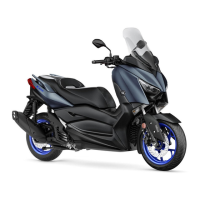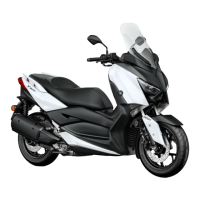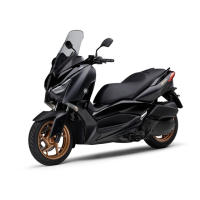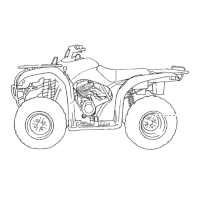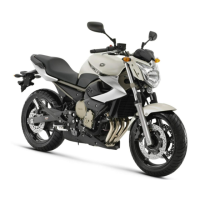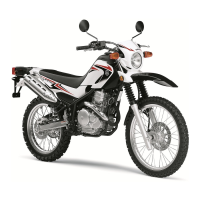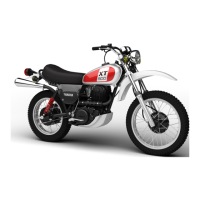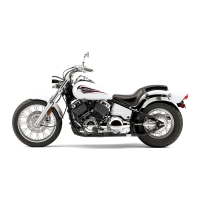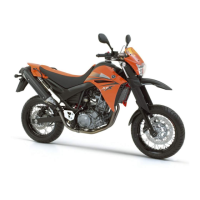Do you have a question about the Yamaha Xmax 250 and is the answer not in the manual?
Explains the meaning of safety alert symbols, warnings, cautions, and notes.
Guidelines for safe riding, posture, controls, and environmental factors.
Recommendations for protective clothing to minimize injury in accidents.
Guidelines for safely adding cargo or accessories to the scooter.
Precautions regarding gasoline flammability and exhaust gas toxicity.
Additional tips for safe riding in various conditions.
Identification of major components visible from the left side.
Identification of major components visible from the right side.
Identification of handlebar controls and dashboard instruments.
Explanation of the vehicle's anti-theft immobilizer system and key usage.
Operation of the ignition and steering lock switch.
Explains the function of dashboard indicator and warning lights.
How to read the fuel gauge and understand the fuel level warning light.
How to read the coolant temperature gauge and handle overheating.
Explanation of the speedometer and its operational limits.
Details of the multi-function display functions like odometer, tripmeters, and clock.
How to switch between odometer and tripmeter displays.
Instructions on how to set the clock on the multi-function display.
Information on the ambient temperature display and frost warning.
Explanation of the service indicator and how to reset it.
Overview and function of the handlebar switches.
How to operate the front brake lever.
How to operate the rear brake lever.
Instructions for removing and installing the fuel tank cap.
Information on checking fuel level and recommended fuel type.
Instructions on how to open and close the seat.
Information on front and under-seat storage compartments.
How to adjust the spring preload on the shock absorber assemblies.
Operation of the sidestand and its associated switch.
Explanation of the ignition circuit cut-off system and its functions.
Importance of pre-operation checks and general points to inspect.
A detailed checklist of items to inspect before operating the vehicle.
How to check brake lever operation and lubrication points.
Step-by-step instructions for starting the engine when cold.
Steps for safely starting off and moving the scooter.
How to control speed using the throttle.
Proper braking techniques, including on wet surfaces.
Instructions for breaking in the engine during the initial period of use.
Correct procedures for parking the scooter safely.
A schedule detailing maintenance tasks and intervals.
Instructions for removing and reinstalling cowlings and body panels.
How to check the spark plug's condition and specifications.
Procedures for checking and changing the engine oil.
Procedures for checking and changing the final transmission oil.
Procedures for checking and changing the coolant.
How to replace air filter elements and clean V-belt case elements.
How to check and adjust the throttle cable free play.
Importance of tire air pressure and how to check it.
Specifications for tire air pressure based on load.
How to check the front and rear brake pads for wear.
How to check the brake fluid level and important precautions.
How to lubricate the pivoting points of the brake levers.
How to check and lubricate the centerstand and sidestand.
How to check the condition and operation of the front fork.
How to check the steering for wear and play.
Information on the sealed-type battery, maintenance, and storage.
Instructions for replacing fuses and a list of fuse specifications.
Step-by-step instructions for replacing a headlight bulb.
How to replace a front turn signal light bulb.
Instructions for replacing tail/brake and rear turn signal light bulbs.
How to replace the license plate light bulb.
How to replace an auxiliary light bulb.
Charts for diagnosing starting problems and poor engine performance.
Troubleshooting steps for engine overheating issues.
Detailed instructions and precautions for cleaning the scooter.
Guidelines for storing the scooter for short and long periods.
Detailed physical dimensions of the scooter.
Technical details about the engine.
Recommended type of fuel for the scooter.
Recommended spark plug model and gap.
Details of the transmission's reduction systems and type.
Details of the front suspension system.
Information on the ignition and charging systems.
Specifications for all bulbs used on the scooter.
List of fuses and their amperage ratings.
Where to find key, vehicle, and model identification numbers.
Information on the vehicle identification number and its use.
Location and purpose of the model label.
Explains the meaning of safety alert symbols, warnings, cautions, and notes.
Guidelines for safe riding, posture, controls, and environmental factors.
Recommendations for protective clothing to minimize injury in accidents.
Guidelines for safely adding cargo or accessories to the scooter.
Precautions regarding gasoline flammability and exhaust gas toxicity.
Additional tips for safe riding in various conditions.
Identification of major components visible from the left side.
Identification of major components visible from the right side.
Identification of handlebar controls and dashboard instruments.
Explanation of the vehicle's anti-theft immobilizer system and key usage.
Operation of the ignition and steering lock switch.
Explains the function of dashboard indicator and warning lights.
How to read the fuel gauge and understand the fuel level warning light.
How to read the coolant temperature gauge and handle overheating.
Explanation of the speedometer and its operational limits.
Details of the multi-function display functions like odometer, tripmeters, and clock.
How to switch between odometer and tripmeter displays.
Instructions on how to set the clock on the multi-function display.
Information on the ambient temperature display and frost warning.
Explanation of the service indicator and how to reset it.
Overview and function of the handlebar switches.
How to operate the front brake lever.
How to operate the rear brake lever.
Instructions for removing and installing the fuel tank cap.
Information on checking fuel level and recommended fuel type.
Instructions on how to open and close the seat.
Information on front and under-seat storage compartments.
How to adjust the spring preload on the shock absorber assemblies.
Operation of the sidestand and its associated switch.
Explanation of the ignition circuit cut-off system and its functions.
Importance of pre-operation checks and general points to inspect.
A detailed checklist of items to inspect before operating the vehicle.
How to check brake lever operation and lubrication points.
Step-by-step instructions for starting the engine when cold.
Steps for safely starting off and moving the scooter.
How to control speed using the throttle.
Proper braking techniques, including on wet surfaces.
Instructions for breaking in the engine during the initial period of use.
Correct procedures for parking the scooter safely.
A schedule detailing maintenance tasks and intervals.
Instructions for removing and reinstalling cowlings and body panels.
How to check the spark plug's condition and specifications.
Procedures for checking and changing the engine oil.
Procedures for checking and changing the final transmission oil.
Procedures for checking and changing the coolant.
How to replace air filter elements and clean V-belt case elements.
How to check and adjust the throttle cable free play.
Importance of tire air pressure and how to check it.
Specifications for tire air pressure based on load.
How to check the front and rear brake pads for wear.
How to check the brake fluid level and important precautions.
How to lubricate the pivoting points of the brake levers.
How to check and lubricate the centerstand and sidestand.
How to check the condition and operation of the front fork.
How to check the steering for wear and play.
Information on the sealed-type battery, maintenance, and storage.
Instructions for replacing fuses and a list of fuse specifications.
Step-by-step instructions for replacing a headlight bulb.
How to replace a front turn signal light bulb.
Instructions for replacing tail/brake and rear turn signal light bulbs.
How to replace the license plate light bulb.
How to replace an auxiliary light bulb.
Charts for diagnosing starting problems and poor engine performance.
Troubleshooting steps for engine overheating issues.
Detailed instructions and precautions for cleaning the scooter.
Guidelines for storing the scooter for short and long periods.
Detailed physical dimensions of the scooter.
Technical details about the engine.
Recommended type of fuel for the scooter.
Recommended spark plug model and gap.
Details of the transmission's reduction systems and type.
Details of the front suspension system.
Information on the ignition and charging systems.
Specifications for all bulbs used on the scooter.
List of fuses and their amperage ratings.
Where to find key, vehicle, and model identification numbers.
Information on the vehicle identification number and its use.
Location and purpose of the model label.
| Engine Type | Liquid-cooled, 4-stroke, SOHC, 4-valve |
|---|---|
| Displacement | 249 cc |
| Compression Ratio | 10.5:1 |
| Fuel System | Fuel Injection |
| Ignition System | TCI |
| Starter System | Electric |
| Transmission | V-Belt Automatic |
| Front Suspension | Telescopic fork |
| Rear Suspension | Unit Swing |
| Front Brake | Hydraulic single disc, Ø267 mm |
| Rear Brake | Hydraulic single disc, Ø245 mm |
| Front Tire | 120/70-15 |
| Rear Tire | 140/70-14 |
| Length x Width x Height | 2, 185 mm x 775 mm x 1, 415 mm |
| Seat Height | 795 mm |
| Wheelbase | 1, 540 mm |
| Minimum Ground Clearance | 135 mm |
| Curb Weight | 179 kg |
| Maximum Torque | 24.3 Nm @ 5, 500 rpm |
| Fuel Tank Capacity | 13.0 L |
| Maximum Power | 22.8 hp @ 7, 000 rpm |
